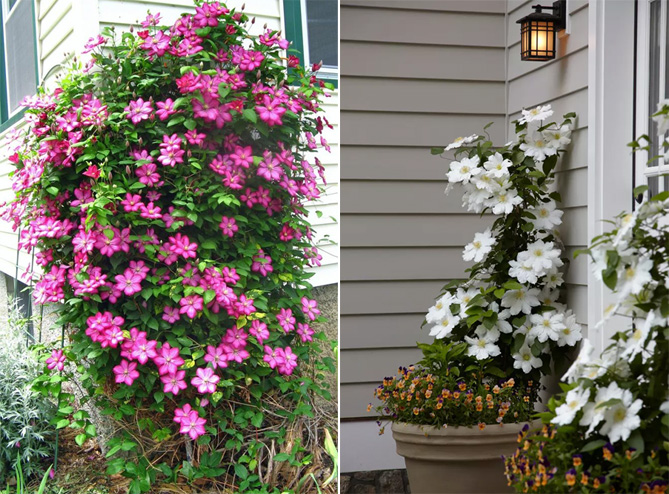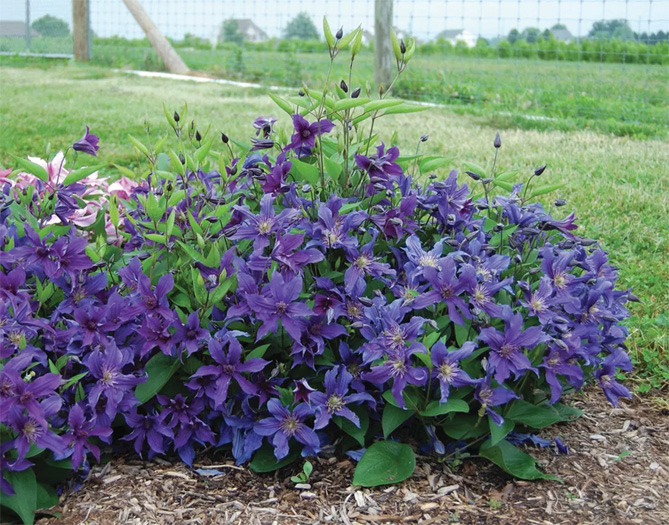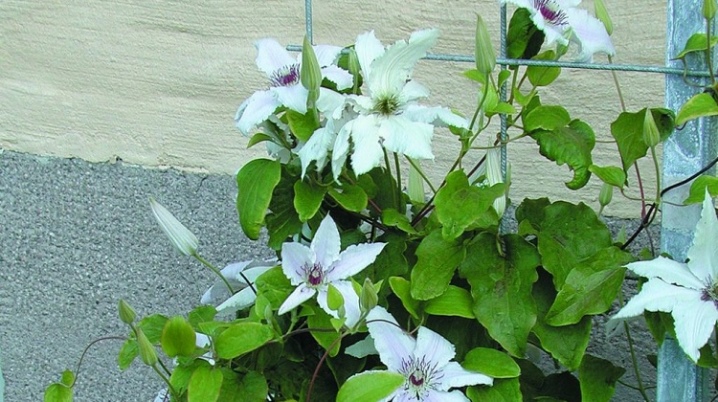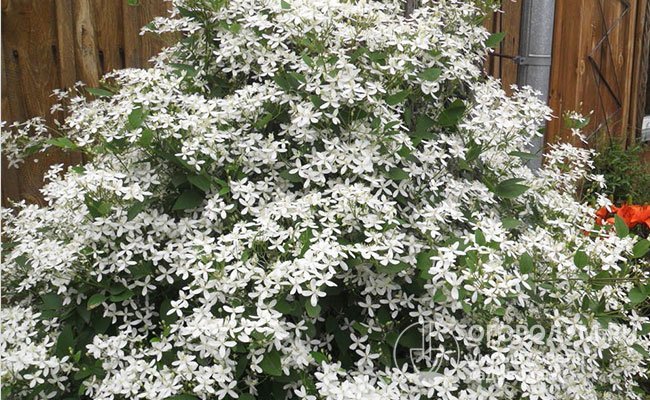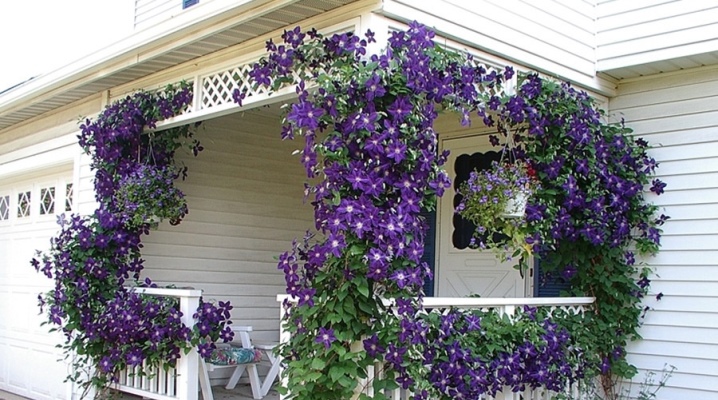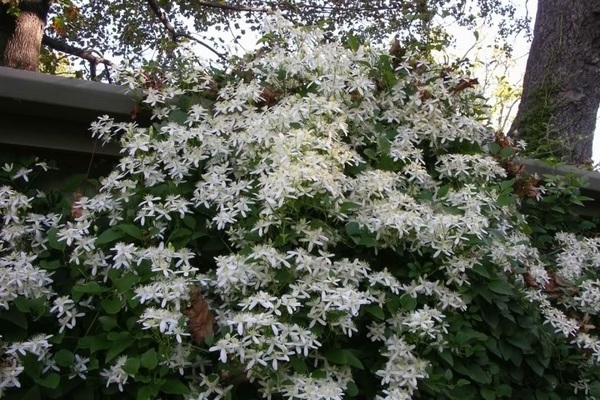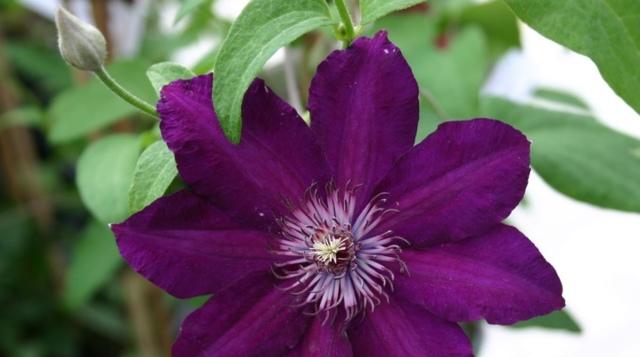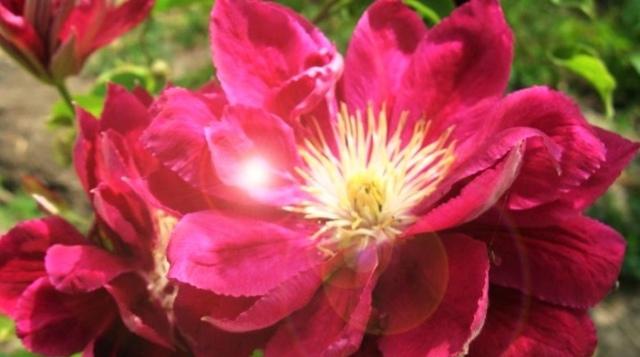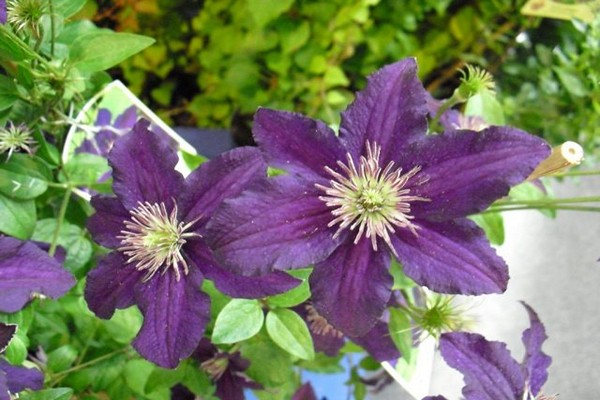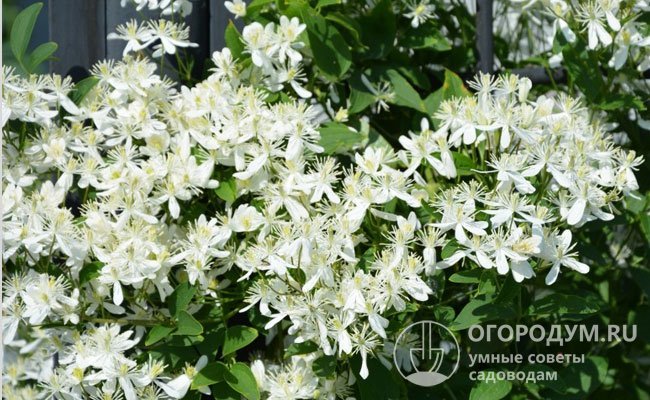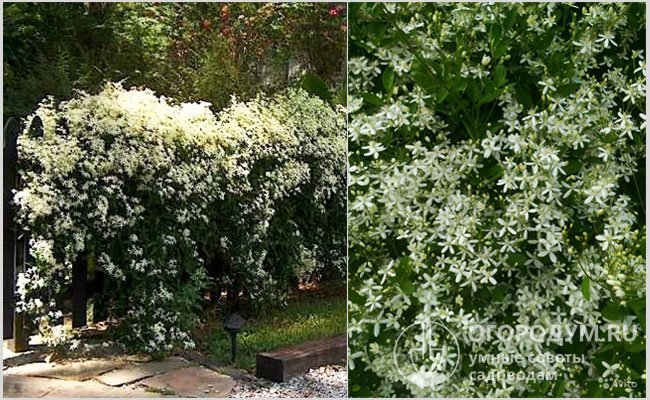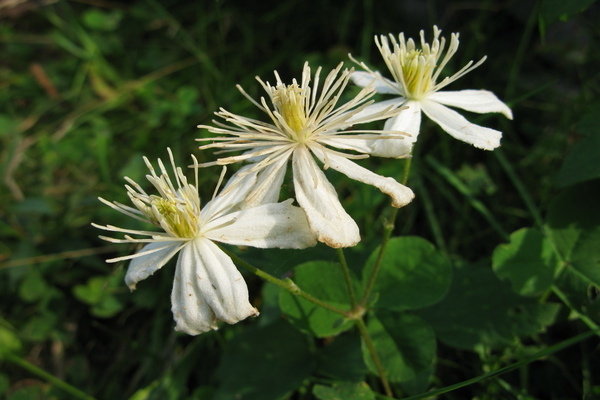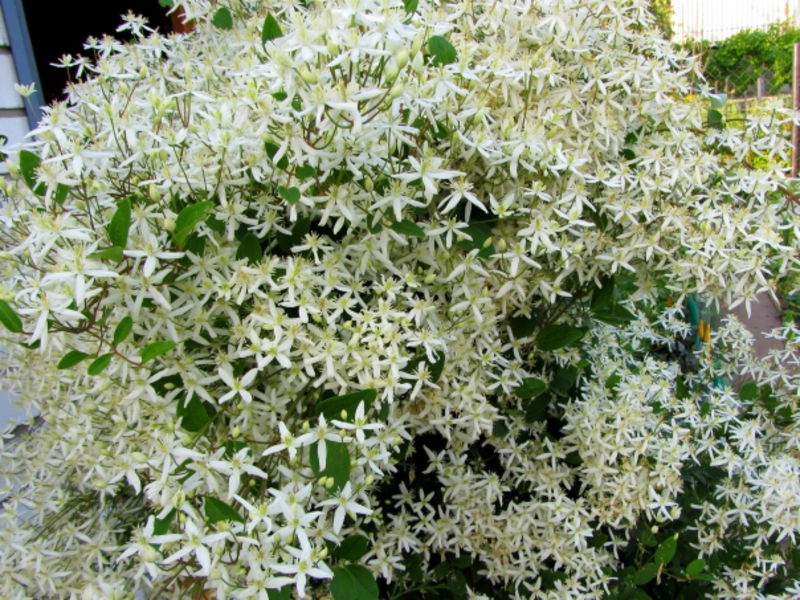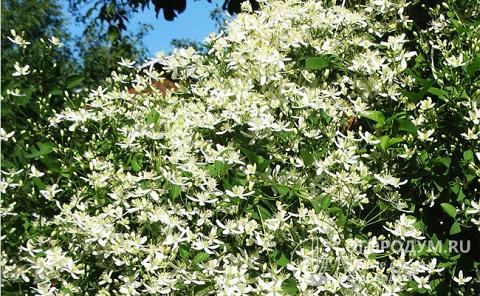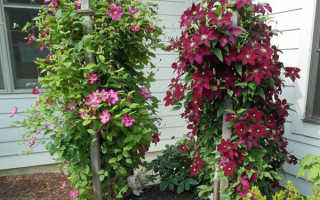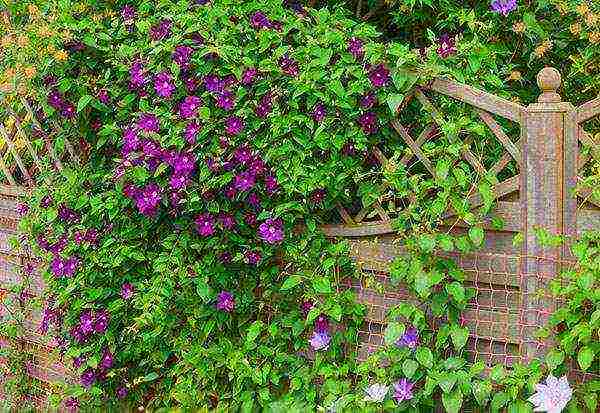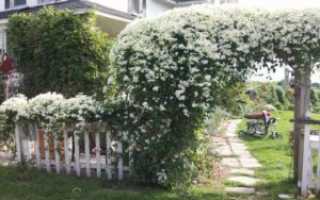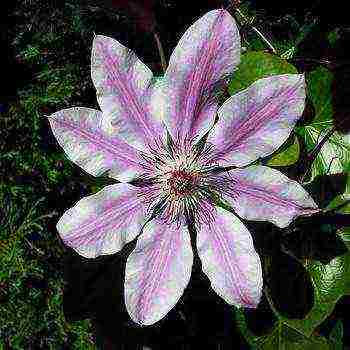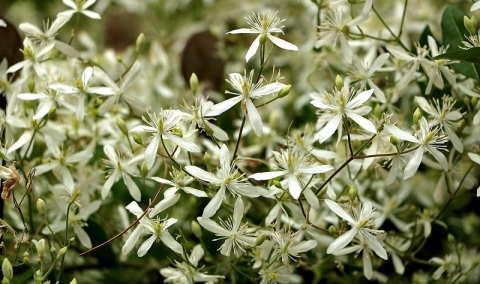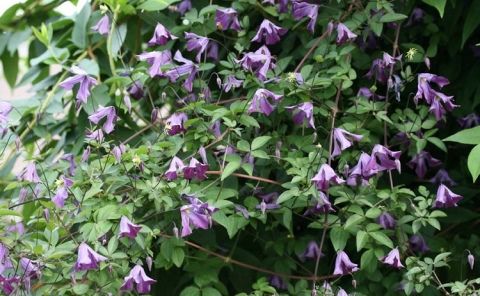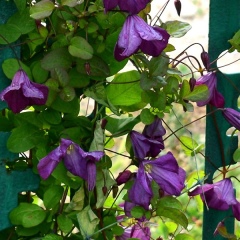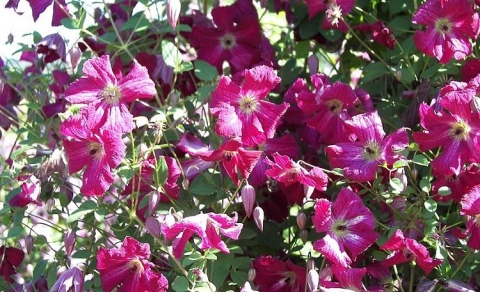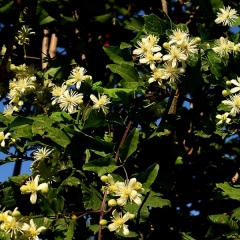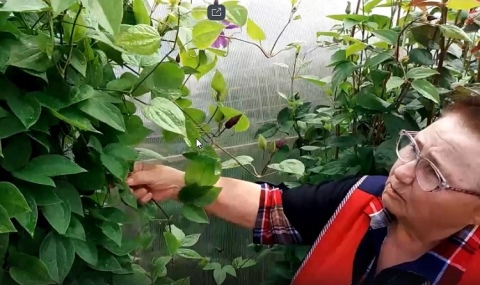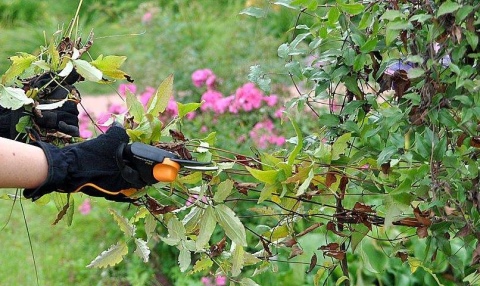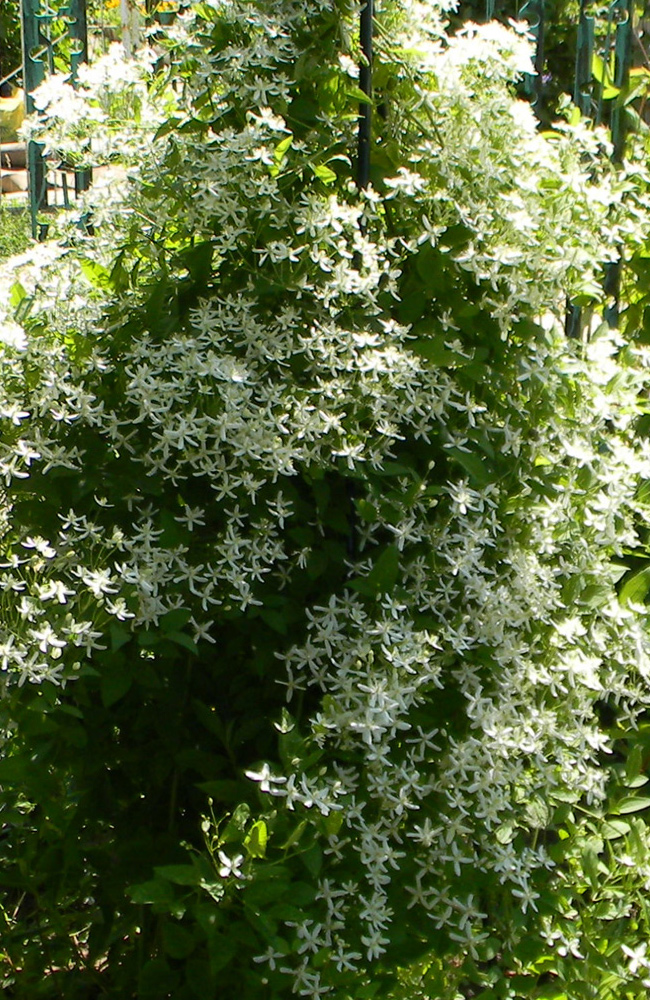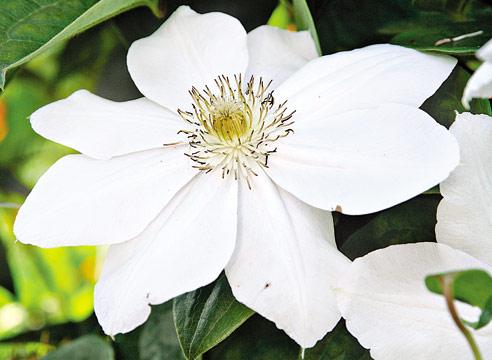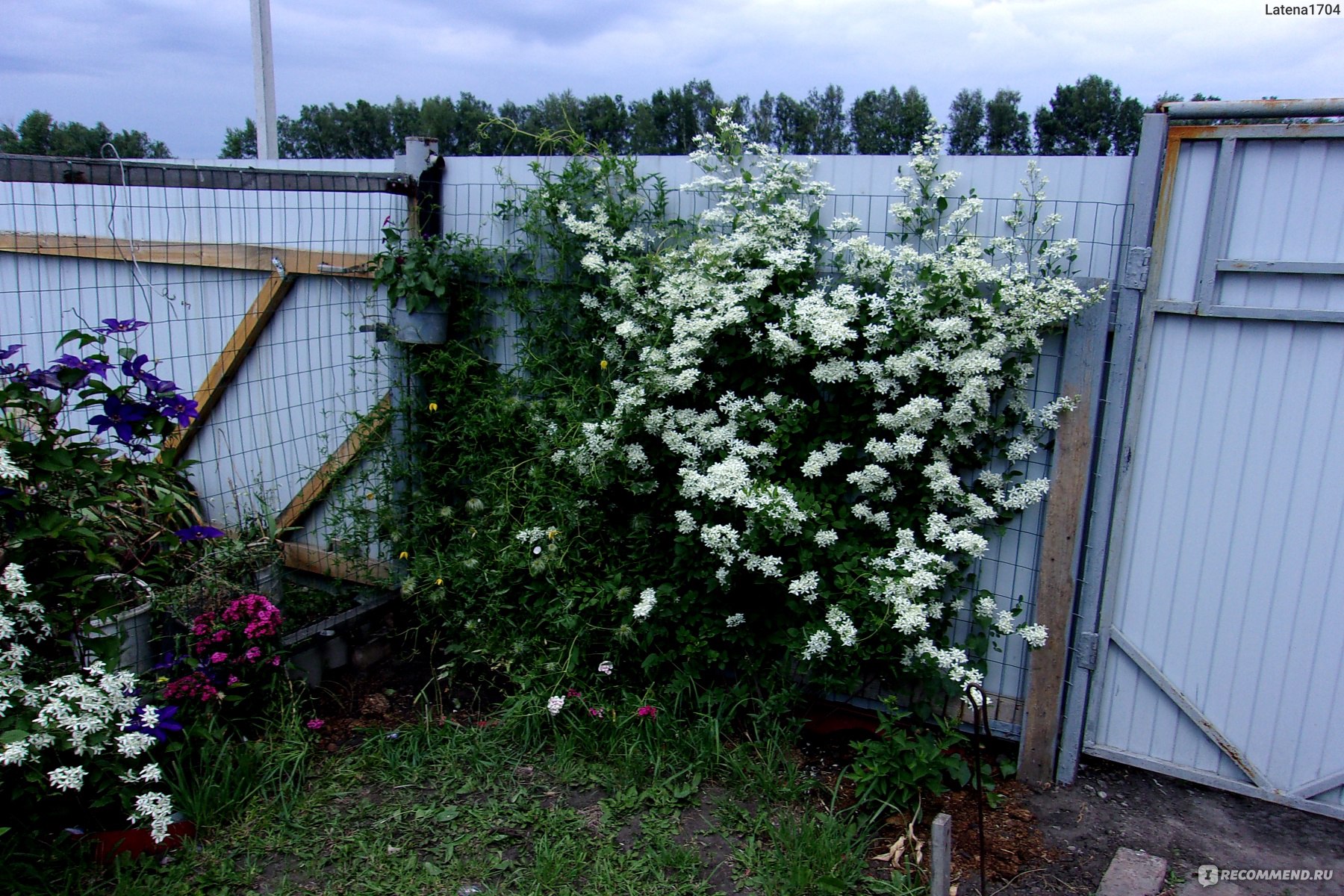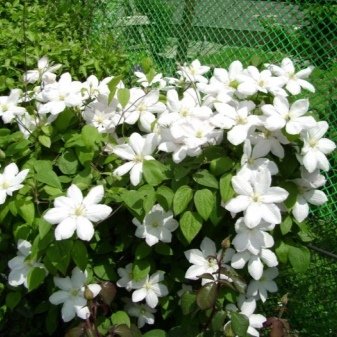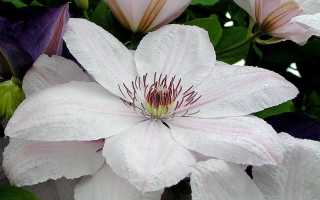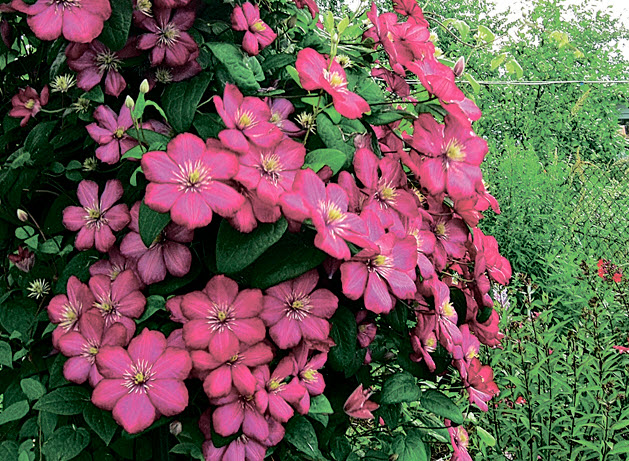Landing
Culture tends to grow in any kind of soil. However, the intensity of flowering and the development of culture depend on the correctly selected planting site.
Seat selection
The bush prefers plenty of sunlight. Therefore, it is planted in places where the sun's rays hit the bush for at least 6-7 hours a day. Also, the landing site should be protected from drafts and wind.
Important. The planting site should not be sultry, otherwise burns may form on the leaves.
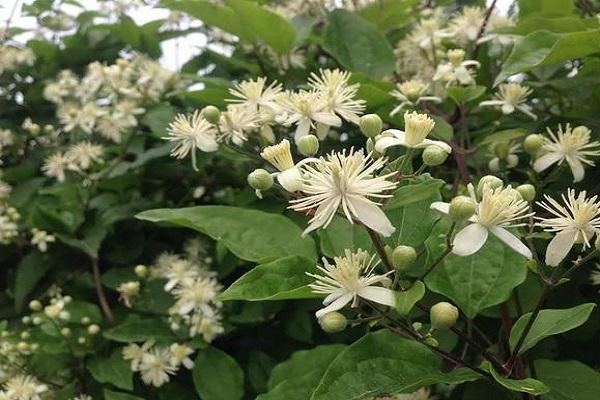
Soil requirements
The plant grows in aerial soils that contain organic fertilizers. The soil should be moist, but in moderation, otherwise putrefactive processes may form in the roots, and the plant will die.
Timing
Planting clematis should be carried out in mid-September, before the first frosts, the plant will have time to get stronger and survive low temperatures. If necessary, clematis seedlings can be planted in mid-April under cover.
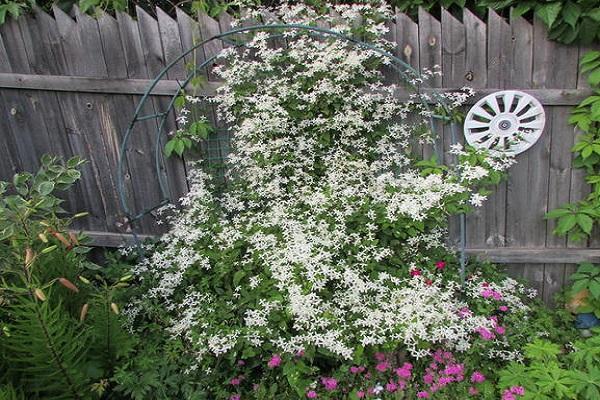
Landing scheme
Before planting, it is necessary to prepare a nutrient mixture for planting a seedling in open ground. To do this, mix 2 parts of humus, part of the soil and part of the sand. It is also necessary to add a pinch of lime to the composition to reduce acidity.
Planting clematis is done according to the following method:
- dig a hole 40 cm;
- drainage is placed at the bottom of the pit;
- the soil is laid in a hole in the shape of a hill;
- the seedling is placed in a hole and dug in to a depth of 15 cm;
- the seedling is watered and mulched on top with a layer of sawdust.
If there is a decrease in air temperature at night, the seedling must be covered.

Burning small-flowered white clematis: what is this plant and how to care for it?
Burning small-flowered white clematis is an original landscape type that is suitable for decorating a plot in a traditional style and requires only minimal maintenance. Planting a plant is not difficult if you adhere to all the necessary rules. The cultivar is a suitable alternative to the large-flowered varieties of clematis. It will especially appeal to people who are not indifferent to the beauty of the wild nature of the South.
According to the description, the plant belongs to the Buttercup family. Burning clematis is considered a type of wild clematis (another name for the plant). This is due to the fact that when you see a vine, its natural appearance gives the impression that it was created not by breeders, but by nature.
You can meet grape-leaved and burning clematis in the wild in northern Africa, Asia, and the Mediterranean. Small-flowered white clematis has been known there for more than 300 centuries. In Russia, culture is found on the territory from Rostov to Tver.
Flowers are small in diameter - up to 30 mm. They have the shape of whitish-greenish stars, which are collected in light "clouds". The plant exudes a pleasant aroma with hints of almonds. The flowering period begins in mid-summer and lasts up to 3 months with proper care. Up to 400 buds can form on one shoot. The seeds are reddish brown.
In landscape design, burning small-flowered clematis is used to decorate walls, gazebos, arches.
Reproduction can be done by seeds. In this case, the varietal characteristics of the mother plant will not change. You need to work with planting material as follows:
- 1. Collect ripe seeds at the end of October, remove lint and spouts.
- 2. Carry out stratification - place in wet sand and refrigerate for 3 months.
- 3. Sow seeds in April or May in the greenhouse. The substrate should be composed of peat and sand in equal proportions.Seeds should be spread evenly on the soil surface, then sprinkled with a thin layer of sand.
Care involves only timely irrigation of the soil. As soon as 2-3 true leaves appear on the bushes, a pick can be made. The next spring, it is allowed to plant plants in a permanent place.
The second breeding method is by dividing the bush. It is necessary to dig an adult plant out of the ground (you can simply dig it from different sides), divide it into several parts and plant each of them in a new place. Seedlings must have at least one root bunch and shoots with vegetative buds.
The third way is to use layering. The procedure is supposed to be carried out only in early spring. You need to do the following:
- 1. Dig a small trench up to 60 mm deep.
- 2. Put the selected healthy and strong branch into it.
- 3. Fix the escape (you can use bricks, metal staples, wire).
It is not necessary to sprinkle the branch with soil immediately, since this reduces the likelihood of seedling development. Such work is recommended to be carried out when a small bush forms on the layer. In the future, care for him is carried out in the same way as for the mother plant. A year after all the manipulations, you need to separate the layer from the mother plant and transplant it to a permanent place.
The last breeding option is cuttings. This process is quite complex, but effective. You can use both lignified and green shoots. The procedure is as follows:
- 1. Cut healthy shoots into pieces of 10 cm. The upper cut should be straight, above the knot, and the lower cut oblique and, conversely, under it.
- 2. Remove the lower branches.
- 3. Treat the stalk with a growth stimulant (Heteroauxin or Kornevin). The place of the lower cut just needs to be dipped in powder.
- 4. Plant the cuttings in a greenhouse or greenhouse, positioning them at an angle to the ground and deepening them by 30 mm.
Further care consists in regular watering and spraying of the cuttings. After 2 months, the seedlings can be placed in the growing garden, and planted in a permanent place next spring or autumn.
{SOURCE}
Popular varieties and their description
Clematis is considered the most popular ornamental plant among designers and gardeners. This lush vine with flowers of extraordinary beauty was brought from Greece, and today it is the main decoration of garden plots and recreation areas. Despite the fact that clematis has more than 800 varieties, white varieties are considered the most common. Most often, the following varieties of white clematis are used for landscape design:
Jerzy Popieluszko. It is an erect shrub with dark green leaves, with snow-white flowers consisting of 8 sepals. Wild clematis usually blooms from May to August, and home grown from June to September. The plant has a 2 pruning group.
Large-flowered
Now on sale you can find white varieties of clematis with different sizes of flowers. Large-flowered plants are easily grown in all climatic zones, while in the middle lane they take root better than in the south. Common varieties of large-flowered clematis include the following representatives.
Arctic Queen. It is a large bush, which in June is covered with white flowers with a diameter of 18 cm. When growing an ornamental plant at home, you need to remember that it loves sunny areas, well protected from the wind.
Small-flowered
Compared to large-flowered clematis, small-flowered clematis have a special charm. Their small buds can give a landscape design a unique look. The small bud of the plant smells good. The only drawback of these varieties is that they do not cling to supports, therefore, they require a garter and timely pruning. Most often, gardeners choose the following small-flowered varieties for home cultivation.
Recta.Creates a beautiful snow-white background in gardens, which can be diluted with colored clematis of other shades. The shoots of the plant are straight, and if they are not tied up, then under the influence of the winds they fall and break. In areas with fertile soil and timely watering, such clematis can grow up to 2.5 m in length.
Terry
Snow-white clematis with double flowers look especially gorgeous in summer cottages; they are often chosen for decorating walls, fences and pergolas. In order to grow a beautiful and healthy plant on your site that does not require special care, you should give preference to the following varieties.
Isago. Ideal for those gardeners who prefer to see monochromatic flower beds in their areas. Clematis of this variety quickly braids the garden supports and decorates the areas with delicate buds.
Bush
Representatives of this species are not curly and differ in bush shape. Despite this, they are practically in no way inferior in their decorative qualities to royal vines. The most popular bush clematis varieties are presented below.
"Hakuri". It is a whole-leafed plant that grows up to 1 m in length. At the end of June, it is abundantly covered with white bell-shaped flowers. Their sepals-petals have a characteristic waviness, so from the inside they curl in an original way.
Clematis large-flowered white
Usually, when presenting clematis, everyone immediately sees in their imagination flowers of large, bright shades. But among the large-flowered species there are also owners of white flowers, which are in no way inferior in beauty to their brightly blooming counterparts.
Description of the Miss Bateman variety
Clematis Miss Bateman is one of the most popular varieties bred by the famous English breeder Charles Knowlb in the 19th century.
The main characteristics of the plant:
- woody liana of medium size, the height of which reaches 2.5 m;
- pruning group B, which means two flowering periods, the first of which occurs in June;
- the plant is very resistant to frost and is immune to diseases and pests;
- Miss Bateman clings well to the support;
- large, up to 16 cm in diameter, flowers;
- flowers consist of 8 petals, in the middle of each of which there is a vertical greenish stripe.
Important! Flowering is very long, lasts until the onset of frost
Description of the variety of clematis Bella (Bella)
Clematis Bella - undersized, no higher than 2 m, variety.
Its advantage is that, despite the small length of the liana, a large number of large white flowers are formed on it, up to 15 cm in diameter.
Looks great against the background of contrasting plants with dark leaves, tolerates winter well, frost will not beat it, it is also resistant to diseases and pests.
Description of the variety of clematis Blekitny Aniol
The name of the variety Blekitny Aniol means "blue angel" in Polish. And most often it is called that way.
Clematis Blue Angel has the following characteristics:
- large-flowered, late-flowering plant;
- trim group C;
- tall plant, up to 4.5 m long;
- flowers up to 15 cm, with 4-6 sepals;
- the color is light lilac or bluish;
- blooms from July until the first frost.

Clematis Blekitny Aniol
Description of the variety of clematis Cassiopeia (Cassiopeia)
Cassiopeia is a beautiful name for a gentle, low-growing variety. They are intended for growing not only in the open field, but also suitable for open verandas and balconies.
Main characteristics:
- height - up to 2 m;
- flower diameter up to 18 cm;
- White color;
- high frost resistance;
- trim group A.
The most unpretentious variety of clematis
There are enough varieties of it, you can choose any:
Manchu - decorative plant resistant to severe cold, blooming luxuriantly with fragrant white flowers, reaches a height of two meters.Its part, which is above the ground, disappears in the autumn, and in the spring it quickly begins to grow, releasing many young branches. The variety was bred specifically for temperate latitudes with a cold climate. It perfectly tolerates any frost.
Bush - the most popular species among people. Such a lobed shrub has become the dream of any clematis collector. There are a lot of branches growing, and they reach a height of up to a meter. Flowers that bloom in August are juicy yellow in color and have a diameter of up to four centimeters. Liana is evergreen, unpretentious, with non-dying shoots.
The president - is distinguished by abundant and long flowering. The blossoming star-shaped flowers have a rich purple hue. With proper care, such a vine blooms twice - May-June and August-September. The president, due to his unpretentiousness, adapts well to different climates.
Burning - long-growing deciduous species has a lush flowering, decorative beauty and winter hardiness. It starts flowering in early summer and ends in August. Climbs well on any support. The flowers are impressive with a strong, delicate aroma.
Zhakman - an original hybrid with huge flowers, obtained from clematis purple, woolly and Henderson. The species with lignified stems is the most popular due to the size of the flowers - up to fifteen centimeters. Differs in cold resistance and a longer flowering period - from mid-summer to mid-autumn. It perfectly frames gazebos, pergolas, arched and other garden structures. This clematis is one of a kind. Its main difference is twenty different large-flowered species that do not require careful maintenance.
Clematis from the Zhakman variety perfectly take root in our latitudes:
Gypsy Queen - moderately growing liana, its height is up to three to four meters. Its feature is abundant flowering. The color of the flowers is a deep purple hue, which can turn into purple. Their diameter is fifteen centimeters. It develops well near the walls of houses, on the trellises of gazebos, near fences, and can also climb shrubs, conifers, deciduous trees and any supports.
Blue flame - the color is fully manifested in the fall, the flowers are large, up to eighteen centimeters in diameter, wide petals are bright blue with light veins. An adult plant reaches a height of three meters, and in order to give a liana a beautiful shape, you just need to build up a support.
Viola - a variety from Estonia is distinguished by long pedicels with velvety dark purple flowers up to twelve centimeters in diameter, with yellow-green stamens. The height of the bush reaches three meters, it ceases to please in August.
Rouge cardinal - grows in height by two meters, the diameter of the loose flowers is ten centimeters, the color is crimson red, the stamens are red. Blooms from July to September.
Such clematis decorate places of rest, create romance and coziness on terraces or on any other site.
Characteristics of clematis species
Over the years of selection, a lot of clematis species have been bred, a large part of which can theoretically be grown in conditions of cool winters.
Some of them are more resistant than others.
Clematis varieties for the Moscow region description of the photo:
Gypsy Queen - from the Jacquemann group, has large purple-violet flowers that appear on new shoots. It is famous for its lush flowering, disease resistance, frost resistance. Grows well in partial shade.
General Sikorski - famous for its large blue-lilac flowers, blooms abundantly, picky and stable. The flowers have an iridescent color of the flower that changes depending on the lighting. Relatively stable against fungal diseases and resistant to moderate frosts.
Nelly Moser - an old variety from the Patens group, has huge white-pink flowers with bright stripes in the center of the petals.It blooms in late spring and summer on old shoots, and then again until cold weather on new shoots that have grown this year. In the bright sun, the flowers fade. It winters well under cover, but it can suffer in especially cold winters, freezing to the roots. It is recovering in a year.
Niobe - has the darkest purple-red flowers. Belongs to the Zhakman group, blooms all summer on young shoots. Winters well under cover. It looks especially elegant against a light background - its velvet flowers seem even richer.

Over the years of selection, a lot of clematis species have been bred, a large part of which can theoretically be grown in conditions of cool winters.
Rouge Cardinal - also a member of the Jacquemann group, blooms extremely abundantly all summer long with large red-purple velvet flowers on this year's shoots. Winter-hardy enough, but can suffer from severe cold weather.
Reproduction of Clematis burning
Seeds are sown in April in open ground or in November - in a greenhouse. In the second case, they emerge even without stratification in July. Seeds are sown in containers with a mixture of sand and earth (1: 2) at a distance of 5–7 cm on the soil surface.
The vegetative method is divided into the following types:
- dividing the bush - an adult bush is dug up or dug in and divided into parts;
- layering - lateral shoots are placed in grooves up to 10 cm deep, pressed with staples, covered with earth. Next year they can already be separated from the mother plant;
- cuttings - planted cuttings are watered with special growth stimulants such as "Epin", "Kornevin", etc. The soil temperature should be at least 18 degrees. The fogging unit maintains a constant humidity. Also, plants should not be allowed to overheat when the sun hits them directly.
For plant propagation, two main methods are used:
- seed type of reproduction
- vegetative reproduction
This type of small-flowered Clematis reproduces successfully by seed. Young seedlings allow you to fully preserve the properties of the maternal perennial.
- To begin with, in the fall, in the second half of October, you need to collect ripe seeds.
- Then clear the seeds from the tuft and carry out stratification. It is necessary to stratify the seeds of this type of Clematis at a low temperature - up to 5 degrees.
- In spring, seeds can be sown in open ground to a depth of 5 cm from the soil surface. Water as needed. In a few weeks, shoots will appear. Shoots develop rather slowly at first, but they will be able to bloom only for 3-4 years.
- You can also plant seeds for seedlings. To do this, the seedlings that have risen in the greenhouse dive into small pots or bags, place them in the light, and water them moderately. They are planted in open ground from the second half of spring. The pots are dropped into the garden bed, mulch, provide watering and feeding. Several times during the growth of the vines, pinch the tops of the shoots. This technique allows you to more intensively build up the vegetative mass of the shrub. The next year, the seedling is transplanted to a permanent place.
This breeding method involves several ways:
- Division of an adult parent shrub into several parts. At the same time, the perennial is completely dug up or dug in from all sides and carefully, so as to damage the aboveground and underground parts as little as possible, divide it. After such manipulation, the plant weakens and will be able to fully recover only after a few years.
- Division by layering. The lower side shoots are pressed to the ground, in specially dug grooves, up to 10 cm deep, fixed with staples and sprinkled with earth. With successful development (the presence of roots), the next year they are separated from the mother bush and planted separately.
- Division by cuttings. Cut the cuttings before flowering, approximately 10 cm long. The upper cut is made above the knot, and the lower one is made under the knot. The lower leaves are cut off.Selected cuttings are recommended to be watered with growth stimulants after planting. They are planted in small greenhouses. The soil for the germination of cuttings should be well warmed up, loosened. On average, after a month, the cuttings take root. It is necessary to gradually accustom them to fresh air by opening the greenhouse. Then they are planted in light partial shade to avoid direct sunlight and possible overheating.
Examples in landscape design
Snow-white clematis is a rather interesting element of any garden composition. Low-growing bushes in the garden are usually planted to decorate roses, and they can also be used to make beautiful living curtains that decorate fences and lower parts of buildings.
This decorative flower also looks interesting in the form of decorations on fences, arches and gazebos. On hot summer days, such a gorgeous clematis fence will save you from the sultry rays of the sun, and in the rain will serve as a reliable shelter. To get beautiful compositions from vines, they must be tied to supports. Lianas weaving over stones look especially luxurious, which can be used when decorating rocky buildings. You can also decorate tree trunks with lianas, placing their stems in a circle.
In the event that the landscape design provides for the presence of several flower beds and flower beds, white clematis can serve as a monochrome background, originally emphasizing the beauty of other flowers. You can also plant clematis in decorative flowerpots and place them both inside and outside the gazebos, on balconies.
In the next video, you will find more information about white clematis.
Features of planting, care and reproduction
The rules for planting Manchurian clematis and caring for an adult liana are almost similar to the agricultural technology recommended for bush varieties of culture. The planting pits are "filled" with fertilizers, while regulating the acidity of the soil with the help of "alkalizing" or "acidifying" additives. In areas with a high level of groundwater, fill beds are formed in advance and drainage grooves are built, and layers of gravel, crushed stone or broken tiles are laid on the bottom of the pits. The seedling is buried in the soil 10-15 cm above the "tillering point" to ensure optimal conditions for root growth. Further care comes down to watering in extreme heat, removing excess stems that over-thicken the bushes, applying dressings and treating with drugs that protect against pests (as needed).
Trimming group
Plants of this species do not need pruning at all for the winter in the sense in which it is customary for large-flowered clematis. At the end of the growing season, the entire aboveground part of the bushes withers. Most gardeners remove dry stems in the fall simply so that they don't interfere with the rapid growth of new shoots in the spring. In regions with long, harsh winters, the soil above the rhizomes is covered with a thick layer of mulch, but in areas with a milder climate, the variety normally hibernates without shelter.
Planting and breeding
Usually, seedlings are placed in well-lit places near low walls, fences, alpine slides and other objects on which it is easy to lay "creeping" stems of vines.
Plants are often placed in well-lit areas; for vertical gardening in open places, various supporting structures (trellises) are installed
To create a vertical "wall", trellises are arranged, to which flexible shoots are tied up as they grow. In this version, the bushes can be grown on a balcony or loggia, used to decorate gazebos, verandas and high fences. The variety looks great in combination with large-flowered clematis (especially those that have flowers of bright colors or "velvety" texture). Its flowering shoots are often made a "background", highlighting the beauty of rose bushes and other ornamental plants.
Manchu clematis goes well with other varieties of culture, especially tall and large-flowered
For gardeners who already have Manchurian clematis on their plots, the question of how to propagate the plant practically does not arise. Unlike the large-flowered forms, this species is easy to grow from seed. Sowing is done in autumn or spring in pre-prepared soil in areas well lit by the sun. Seedlings appear at the moment when the soil warms up to a temperature not lower than +25 degrees
Planting needs frequent watering, regular weeding and careful loosening of the soil in the root zone. Young shoots should be pinched to provide the seedlings with the opportunity to quickly build up the required root mass.
For the winter, young clematis are covered with a thick layer of mulch. The first flowering occurs in 2-3 years, after which the plants can be transplanted to a permanent place. In this way, a large number of seedlings are simultaneously grown, which are necessary, for example, for decorating a long, low fence. If the summer resident needs only a few young clematis, he can resort to propagation by cuttings or layering. These methods are also not difficult and allow you to get healthy and viable planting material within one season.
Manchurian clematis seeds are produced and sold by many domestic agricultural firms
Seeds of the described type are offered by such well-known companies as "Gavrish", "Aelita" and many others. Unfortunately, the purchase of their products does not always guarantee the opportunity to grow a favorite clematis. Many gardeners note that they were faced with re-grading or were forced to sow material with low germination. In such a situation, the best way to acquire high-quality seeds is to obtain them from familiar gardeners right at the place where the vine grows.


